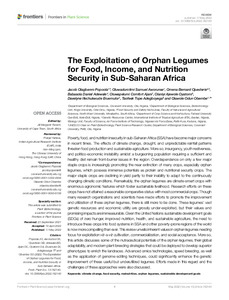| dc.contributor.author | Popoola, J.O. |
| dc.contributor.author | Aworunse, O.S. |
| dc.contributor.author | Ojuederie, O.B. |
| dc.contributor.author | Adewale, D.B. |
| dc.contributor.author | Ajani, O.C. |
| dc.contributor.author | Oyatomi, O. |
| dc.contributor.author | Eruemulor, D.I. |
| dc.contributor.author | Adegboyega, T.T. |
| dc.contributor.author | Obembe, O. |
| dc.date.accessioned | 2022-07-13T09:42:59Z |
| dc.date.available | 2022-07-13T09:42:59Z |
| dc.date.issued | 2022 |
| dc.identifier.citation | Popoola, J.O., Aworunse, O.S., Ojuederie, O.B., Adewale, B.D., Ajani, O.C., Oyatomi, O., ... & Obembe, O. (2022). The The exploitation of orphan legumes for food, income, and nutrition security in sub-Saharan Africa. Frontiers in Plant Science, 13: 782140, 1-21. |
| dc.identifier.issn | 1664-462X |
| dc.identifier.uri | https://hdl.handle.net/20.500.12478/7543 |
| dc.description.abstract | Poverty, food, and nutrition insecurity in sub-Saharan Africa (SSA) have become major concerns in recent times. The effects of climate change, drought, and unpredictable rainfall patterns threaten food production and sustainable agriculture. More so, insurgency, youth restiveness, and politico-economic instability amidst a burgeoning population requiring a sufficient and healthy diet remain front-burner issues in the region. Overdependence on only a few major staple crops is increasingly promoting the near extinction of many crops, especially orphan legumes, which possess immense potentials as protein and nutritional security crops. The major staple crops are declining in yield partly to their inability to adapt to the continuously changing climatic conditions. Remarkably, the orphan legumes are climate-smart crops with enormous agronomic features which foster sustainable livelihood. Research efforts on these crops have not attained a reasonable comparative status with most commercial crops. Though many research organizations and scientists have made efforts to promote the improvement and utilization of these orphan legumes, there is still more to be done. These legumes’ vast genetic resources and economic utility are grossly under-exploited, but their values and promising impacts are immeasurable. Given the United Nations sustainable development goals (SDGs) of zero hunger, improved nutrition, health, and sustainable agriculture, the need to introduce these crops into food systems in SSA and other poverty-prone regions of the world is now more compelling than ever. This review unveils inherent values in orphan legumes needing focus for exploitation viz-a-viz cultivation, commercialization, and social acceptance. More so, this article discusses some of the nutraceutical potentials of the orphan legumes, their global adaptability, and modern plant breeding strategies that could be deployed to develop superior phenotypes to enrich the landraces. Advanced omics technologies, speed breeding, as well as the application of genome editing techniques, could significantly enhance the genetic improvement of these useful but underutilized legumes. Efforts made in this regard and the challenges of these approaches were also discussed. |
| dc.format.extent | 1-21 |
| dc.language.iso | en |
| dc.subject | Climate Change |
| dc.subject | Food Security |
| dc.subject | Malnutrition |
| dc.subject | Grain Legumes |
| dc.subject | Sustainable Development Goals |
| dc.subject | Sub-Saharan Africa |
| dc.title | The exploitation of orphan legumes for food, income, and nutrition security in sub-Saharan Africa |
| dc.type | Journal Article |
| cg.contributor.affiliation | Covenant University |
| cg.contributor.affiliation | Kings University, Nigeria |
| cg.contributor.affiliation | North-West University, South Africa |
| cg.contributor.affiliation | Federal University Oye-Ekiti |
| cg.contributor.affiliation | International Institute of Tropical Agriculture |
| cg.contributor.affiliation | Air Force Institute of Technology, Nigerian Air Force Base |
| cg.coverage.region | Africa |
| cg.coverage.region | West Africa |
| cg.coverage.country | Nigeria |
| cg.coverage.hub | Headquarters and Western Africa Hub |
| cg.researchtheme | Biotech and Plant Breeding |
| cg.identifier.bibtexciteid | POPOOLA:2022 |
| cg.isijournal | ISI Journal |
| cg.authorship.types | CGIAR and developing country institute |
| cg.iitasubject | Agronomy |
| cg.iitasubject | Climate Change |
| cg.iitasubject | Food Security |
| cg.iitasubject | Grain Legumes |
| cg.iitasubject | Plant Breeding |
| cg.iitasubject | Plant Production |
| cg.iitasubject | Socioeconomy |
| cg.iitasubject | Value Chains |
| cg.journal | Frontiers in Plant Science |
| cg.notes | Open Access Journal; Published online: 17 May 2022 |
| cg.accessibilitystatus | Open Access |
| cg.reviewstatus | Peer Review |
| cg.usagerightslicense | Creative Commons Attribution 4.0 (CC BY 0.0) |
| cg.targetaudience | Scientists |
| cg.identifier.doi | https://dx.doi.org/10.3389/fpls.2022.782140 |
| cg.futureupdate.required | No |
| cg.identifier.issue | 782140 |
| cg.identifier.volume | 13 |

